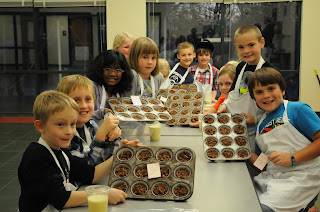 |
| Great Grains Culinary Boot Camp for our sta |
 |
| Chef Samantha Cowens-Gasbarro works with students in classroom school garden cooking activity |
Why a chef??
A 2015 study by Harvard T.H. Chan School of Public Health has shown that "chef enhanced school meals increase healthy food consumption."
The study shows evidence that while hosting Guest Chef events at schools can add excitement and lend positive public relations to school nutrition programs, having a chef on staff who tests and develops recipes and trains & supports school nutrition staff results in children learning to like AND enjoy healthy whole grains, fruits, and vegetables. The study showed that hiring a chef who works with district school nutrition personnel improved the quality, flavor and palatability of the food, and not only decreases plate waste, but increases school meal participation.
While our district was not part of this study, it could have been. The research and outcomes have been mirrored in our district, since hiring our chef, Chef Samantha Cowens-Gasbarro as part of our School Nutrition team. Chef Sam's culinary expertise has not only significantly impacted our staff's training level, acceptance of our menus and our participation but her presence & influence as part of our school nutrition team has encouraged students to embrace nutritious & healthy choices.
While our district was not part of this study, it could have been. The research and outcomes have been mirrored in our district, since hiring our chef, Chef Samantha Cowens-Gasbarro as part of our School Nutrition team. Chef Sam's culinary expertise has not only significantly impacted our staff's training level, acceptance of our menus and our participation but her presence & influence as part of our school nutrition team has encouraged students to embrace nutritious & healthy choices.
Chef Sam’s duties include developing and taste testing new
 recipes & foods, training and supporting staff as we increase “from scratch” cooking, adapting existing recipes to meet current USDA guidelines while maintaining palatability, and consistent culinary skill building with staff to increase productivity, efficiency and safety in the kitchen. Chef Sam frequently works in the school kitchens, alongside school nutrition staff, making delicious and healthy meals. This school year, we have been rolling out several new & exciting menu items, as well as working with our own signature herb & spice blends to decrease sodium in our recipes. Across the board, the students are responding with rave reviews!
recipes & foods, training and supporting staff as we increase “from scratch” cooking, adapting existing recipes to meet current USDA guidelines while maintaining palatability, and consistent culinary skill building with staff to increase productivity, efficiency and safety in the kitchen. Chef Sam frequently works in the school kitchens, alongside school nutrition staff, making delicious and healthy meals. This school year, we have been rolling out several new & exciting menu items, as well as working with our own signature herb & spice blends to decrease sodium in our recipes. Across the board, the students are responding with rave reviews!
Chef Sam is a frequent visitor in classes, weaving good nutrition & healthy eating into our district's curriculum. In class, students get to cook recipes such as curried carrot soup & carrot muffins made with school grown carrots. They also get to taste test recipes &
 name them fun creative names for future menus. Lessons include learning to read nutrition labels & introduction to new, healthy foods. After school cooking classes also help to teach students more about healthy cooking and eating, as well as serve as a bridge to our districts families, as we send home samples and recipes and we get to meet parents during pick up time after class.
name them fun creative names for future menus. Lessons include learning to read nutrition labels & introduction to new, healthy foods. After school cooking classes also help to teach students more about healthy cooking and eating, as well as serve as a bridge to our districts families, as we send home samples and recipes and we get to meet parents during pick up time after class.
Chefs are practically celebrities these days, with so many cooking shows on television and in the media, and school chefs are no exception. There is incredible excitement when Chef Sam is in the kitchen. Her delicious & nutritious health centered approach to cooking & eating inspires our menus, inspires our students and inspires us! Any school district looking to build participation, credibility, excitement and enthusiasm for the school nutrition program should consider adding a chef to their team. When chefs become part of a school nutrition team, the results are increased school meal enthusiasm, increased participation, decreased plate waste, and most importantly, increased consumption of healthy foods, including fruits, vegetables and whole grains in children.
 |
| Fresh & Local - Lasagna made with fresh pasta |
Adding a chef to our School Nutrition team has been a practical, sustainable way to embrace the Chefs Move to Schools movement. Chef Sam has been an integral part of the growth of our School Nutrition Program. Our school nutrition team has passion & commitment to serving children the healthiest, most delicious & nutritious meals, and having a chef on staff has infused our team with fresh vision for the future of School Nutrition.















